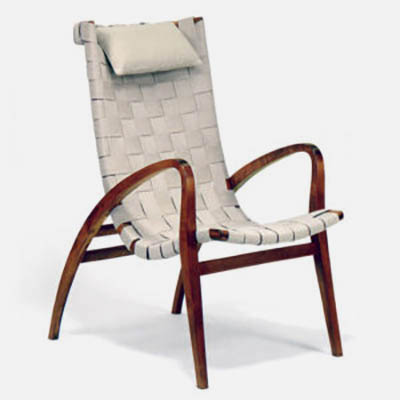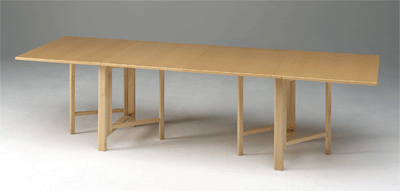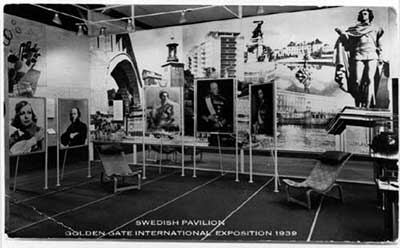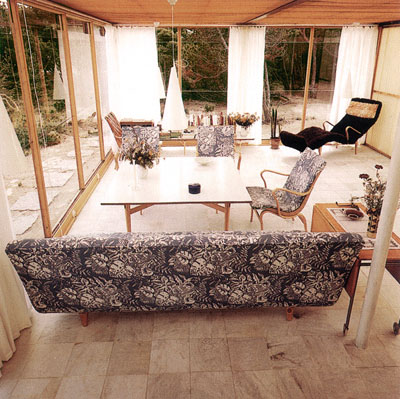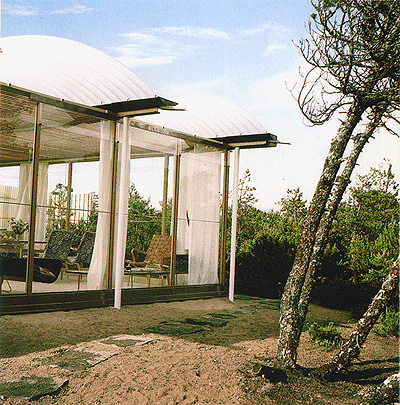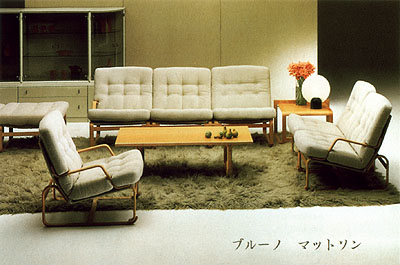BRUNO MATHSSON
Bruno Mathsson
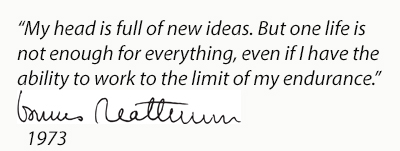
A little tense for the meeting with the famous furniture designer I had arrived in good time outside his parents ´home, which also served as a cabinet makers workshop and office, at Tånnögatan in Värnamo. I was expecting to meet a serious and disciplined architect. Exactly on time, a fiery red open top Rover arrived driven by Bruno Mathsson wearing casual sports wear crowned with
an elegant leather pilots helmet. It was magnificent entry worthy of a master of the functionalist language. This is how the late manager Henry Thelander related the story of his first meeting with Professor Bruno Mathsson which led to a lifelong friendship.
Henry Thelander became Bruno Mathsson 's working partner and their close cooperation continued for more than forty years. Henry´s sons, Bo and Dan, now carry forward this cultural tradition in the company Bruno Mathsson International AB. Bruno Mathsson was born to cabinet making. His father, Karl Mathsson was the fifth generation in a family of master cabinet makers. It was natural that Bruno should follow in his father 's footsteps and from an early age he was taught the necessary skills acquiring a well developed feeling for the characteristics of wood as well as a solid technical knowledge.
For Bruno Mathsson this simply was not enough. From a young age, he was fascinated by the challenge of designing functional furniture combined with high technical quality and it was the ideas of the functionalist movement that were to inspire him.In 1929, came the opportunity to borrow books and magazines from Röhsska Arts and Crafts Museum in Gothenburg and its curator Gustaf Munthe became a contact who was to have an influence on Bruno Mathsson 's career. Soon large boxes filled with books were sent by train between Gothenburg and Värnamo and Bruno Mathsson educated himself through detailed study.
In 1930, Värnamo hosted an Arts and Crafts exhibition where the Karl Mathsson workshop showed a traditional baroque-style chair worked on by Bruno Mathsson. The chair won Bruno Mathsson a scholarship and with it the opportunity to visit the exhibition in Stockholm that saw the launch of the Swedish functionalist movement. The Stockholm exhibition had a major influence on Bruno Mathsson. In spite of his critical approach, he gained a significant insight that something new was developing. This recognition combined with his intense studies of the material borrowed from Röhsska Arts and Crafts Museum released him from the traditional thinking of his fathers workshop to find his own design language.
In 1930, the opportunity arose to put his theories into practice when he was commissioned to design a new chair for Värnamo Hospital. His idea for designing a comfortable chair without traditional sprung upholstery led to an unusual solution. The chair, nicknamed Grasshopper by the hospital staff,was made using a frame covered with plaited webbing supported by arms and legs in solid birch. The controversial chairs were put away by the hospital staff to remain hidden until after Bruno Mathsson became famous.
However, with his appetite wetted, Bruno Mathsson energetically continued to develop his ideas.He care fully studied the "mechanics of sitting ". For example, in search of the perfect seating curve he sat in a snow-drift to study the imprint his body had made. He began experimenting with the techniques of bent laminating wood gaining the skills to make components of great strength with gracefully executed minimalist details. Between 1933 and 1936, this work resulted amongst other things in the three basic chairs called working, easy and loungechair model 36.These chairs were designed using a one piece frame covered with plaited webbing supported by separate bent laminated legs.
Early in 1936, Gustaf Munthe the curator at the Röhsska Arts and Crafts Museum, gave Bruno Mathsson the opportunity to have a one man exhibition at the museum. The exhibition was opened in Gothenburg on March 14, 1936 and gave Mathsson the chance to show his ideas to a bigger audience. Among the exhibits were his new series of chairs and an ingenious folding table. The great success of the exhibition was the breakthrough which signalled the recognition of Bruno Mathsson as a leading designer in Sweden.
By 1937, a year after the exhibition at Röhsska Arts and Craft Museum, Bruno Mathsson was represented at the world exhibition Paris Expo, winning a Grand Prix for his bed "Paris ". During Paris Expo, his furniture was appreciated and admired by an international audience gaining interest from all over the world. This included the manager for the design department of Museum of Modern Art in New York, Edgar Kaufmann jr. who two years later in 1939 ordered chairs by Bruno Mathsson for a new extension of the museum. In the same year his furniture was represented at other exhibitions such as the world exhibition in New York and at the Golden Gate-exhibition in San Francisco.
The leading commentator in the field of culture at the Swedish Crafts Association, Gotthard Johansson, visited the Museum of Modern Art and experienced Bruno Mathsson's furniture. In May 1940, he enthusiastically wrote a long article in the leading Swedish newspaper Svenska Dagbladet: "One single modern Swedish furniture-artist holds an exceptional position. His name soon to be internationally known is Bruno Mathsson from Värnamo. He is without doubt one the most individual figures in the Swedish arts industry"..." when I this Summer found the furniture in the worlds most exclusive exhibition hall, I felt for the first time in my life a secret pride of being born only 20 km from Värnamo". This acknowledgement was significant for the self taught Bruno Mathsson.
Between 1948 - 1949, Bruno Mathsson with his wife Karin paid a longer visit to the USA. During their travels the couple were introduced through Edgar Kaufmann jr. to the most influential architects on that continent. These contacts inspired Bruno Mathsson to create his famous glasshouses using a concrete plate equipped with electrical under floor heating laid directly on the ground. The first example completed in 1950 was his own furniture showroom in Värnamo. One wall was made of brick the other three of Bruno Mathsson's own patented design. "Brunopane", consisting of a triple glazed window with the air gaps filled with insulating nitrogen. Close to nature, the house reflected Bruno Mathsson's love of function and light.
This first building raised enormous interest and during the following decade a significant number of houses were produced using Mathsson principles. However, when building permission was sought it often met with bureaucratic resistance. Different local authority officials questioned the pioneering design and Bruno Mathsson grew tired of the intransigence he met.
Finally in 1960, he ceased constructing houses apart from those he was to design for himself and Karin. That year the couple who were living in a rented wing to Toftaholms Manor-Hotel, built their first house at Frösakull on the Swedish west coast, a Summer house where the line between the inside and outside almost ceased to exist. Between 1964 and 1965 a permanent villa was built by the shore of lake Vidöstern south of Värnamo and in 1973 a house in Vilamoura, Portugal, where the couple were to spend many Winters.
During the 1960´s, Bruno Mathsson returned to creating furniture producing a wide range of designs in both wood and steel. Together with the Danish poet and mathematician Piet Hein, he developed the Superellipse table and the Spanleg. In 1969 Bruno Mathssons furniture was first shown in Japan and in September 1974 Karin and Bruno Mathsson made their first visit to that country. On the initiative of the Japanese, a exhibition was opened in the Swedish Centre Building in Tokyo. This was to lead in 1976 to Bruno Mathsson developing a furniture collection adapted for the Japanese market and licensed manufacturing began. Today both licensed and Swedish produced furniture are sold successfully in Japan.
Today both licensed and Swedish produced furniture are sold successfully in Japan. Bruno Mathsson made several return journeys to Japan participating on one occasion on a panel discussing design with several hundred interior architects in Tokyo .
Ulf Hård af Segerstad, PhD, cultural writer at the Swedish newspaper Svenska Dagbladet, reported: "They wanted to know about the ´Mathsson method´, not so easy to explain even for the best of translators. Finally, Bruno Mathsson asked for a big piece of paper, placed it on the floor, asked a listener to lie down on his side on the paper and drew with his pen a more or less elegant contour along the Japanese back from the shoulders to the feet. The pedagogical trick aroused characteristically moderate Japanese enthusiasm and revealed drastic differences between traditionally eastern sitting on the floor and western sitting in chairs".
On his return to Sweden, the tireless Bruno Mathsson continued designing. He had won such worldwide recognition that on his return to New York to exhibit at the Museum of Modern Art in 1978, the New York Times wrote a headline "Bruno is back". During his lifetime he was awarded a number of distinctions including the Gregor Paulssons-statyette (1955), Prince Eugens gold medal (1965), Knight of the Royal Swedish Order of the Wasa (1967), member of The Royal Society of Art, London (1978) and assigned the title professor by the Swedish government (1981).
Bruno Mathsson was a striking artist, self-willed and stubborn. He lived with and for his art and never appeared to grow tired in his eagerness to create new furniture for a new time. In 1981, at seventy-four years of age, he created a workstation for computer users. The workstation is equipped with a so called "wing" that supports the users shoulders.
Following illness, Bruno Mathsson died in 1988 leaving behind a rich cultural heritage. His designs remain timeless. They are looked upon both as art and as utility goods whilst simultaneously being displayed in museums. To each new generation they appear modern, fresh and functional. Photo/Copyright: Bruno Mathsson International AB


